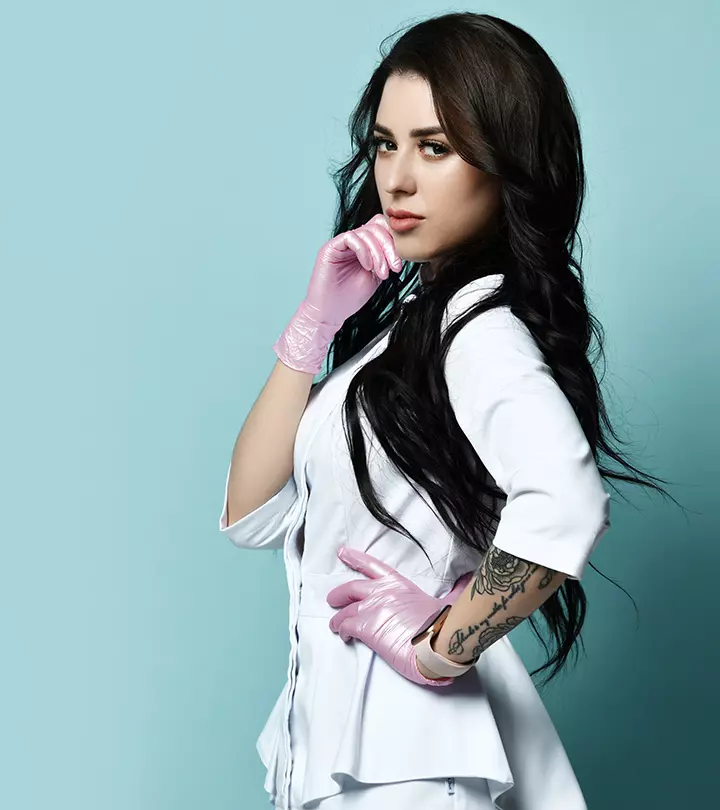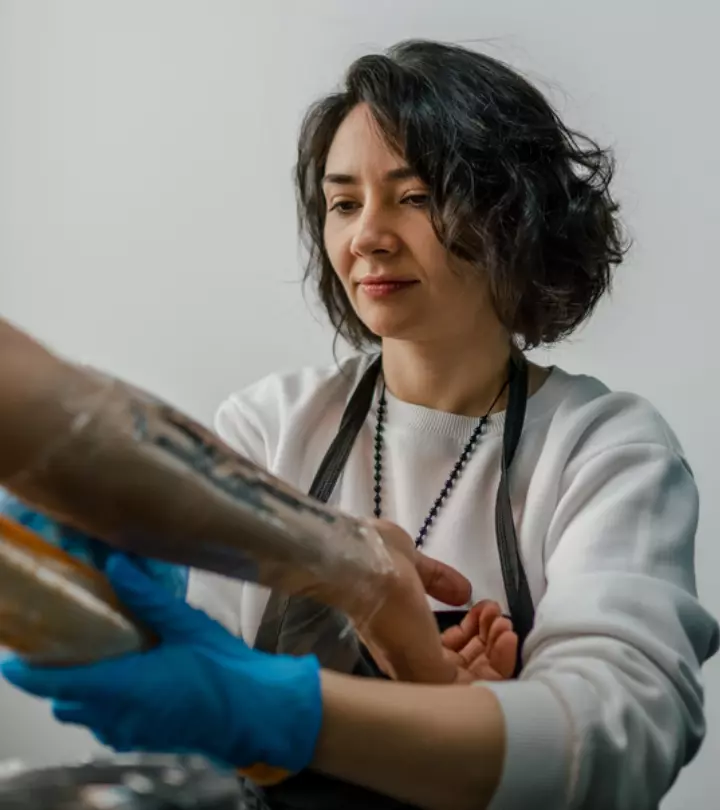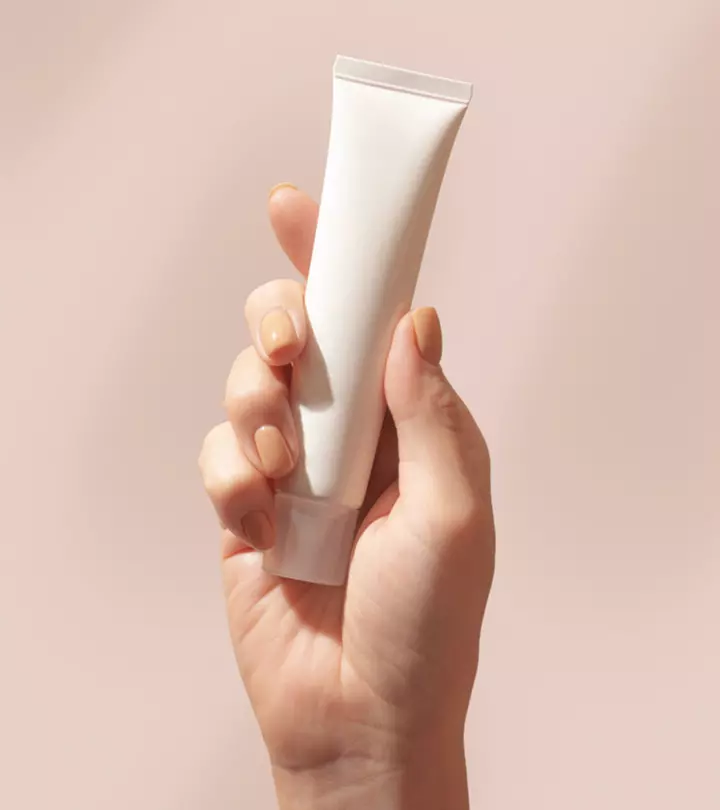Do Numbing Creams Work For Tattoos? A Complete Guide
Improve the precision of the tattooing process without feeling much pain or discomfort.

Image: Shutterstock
Getting a tattoo can be an exciting, fun, and a bit painful experience too. It can serve as a sweet reminder of your loved one, indicate a stage of transformation in your life, or be a sign to commemorate the passing of your dear ones. However, the physical pain that one endures during the tattooing process is debilitating. It can be even more challenging if it involves areas of the body that facilitate lots of movement. Every movement you make reminds you of the painful tattoo session and leaves you wondering why you even went for it. Also, it burns a hole in your pocket. In short, it hurts in more ways than one! Is there a respite from it? Yes, that’s where the numbing creams enter the scene. They are like allies in the battle that can be applied during the tattooing process to minimize the perception of pain. They aren’t a magic solution or act as a substitute for rest or recovery but are incredibly effective in kickstarting the pain relieving process before tattooing, adding to the overall relaxation experience.
Now, let’s understand what they are and how they help to make a tattooing experience a breeze.
In This Article
What Is A Tattoo Numbing Cream?

Numbing creams, as the name suggests, are over-the-counter products used to numb the skin before undergoing a cosmetic process, skin treatment, and medical or tattoo procedure. They help reduce the pain and discomfort you feel during the tattooing process, but cannot really eliminate the pain. A numbing cream works like a topical anesthetic that helps reduce sensitivity to pain by blocking the nerve signals in the areas of the body where it is applied. It contains active ingredients, such as lidocaine or benzocaine, that help provide quick pain relief, soothe the skin, and enhance comfort while undergoing the tattooing process or even during the tattoo removal process.
Understanding what does a tattoo feel like can help prepare you mentally for the process, but for some, the pain is an unavoidable concern. Chloe, a blogger, shared her experience of using a numbing cream. She writes, “I was pretty nervous about getting it done, but I actually didn’t need to be because I didn’t feel any pain at all! The numbing cream I used made it feel like as if someone was writing on me with a pen (i).” The blogger was very pleased with the results of the numbing cream and felt that it eased the pain of the needle-based process.
There are several numbing creams available on the market depending on your specific needs, skin type, skin sensitivity, preferences, and the nature of the procedures. Let’s take a look at it!
Key Takeaways
- Tattoo-numbing creams contain active ingredients that help to provide quick relief from the pain during the tattooing or its removal process.
- Numbing creams are available as over-the-counter creams and prescription-strength creams, based on their concentration and strength.
- While numbing creams do help to reduce pain, they may have potential side effects like allergic reactions, skin irritations, etc.
- Numbing creams cannot eliminate the pain completely but do help to reduce discomfort during the tattooing or tattoo removal process.
What Are The Different Types Of Numbing Creams For Tattoos?
Skin-numbing creams mostly vary in concentration and strength. They can broadly be divided into two types:
- Over-the-counter numbing creams
- Prescription-strength numbing creams
The basic difference between these two is that they differ in the level of concentration of active ingredients and the numbing effect they produce. Minor surgeries or medical procedures might require topical application of creams with lower concentrations whereas invasive tattooing procedures might require creams with higher concentrations of active ingredients. The commonly used active ingredients in tattoo numbing creams are lidocaine, benzocaine, pramoxine, tetracaine, and dibucaine.
Typically, prescription-strength numbing creams are used in clinical settings, to monitor the patient and ensure safe and proper application. They are usually used under the guidance of healthcare professionals as they contain a higher concentration of anesthetic agents and monitor potential side effects. While, over-the-counter creams do not necessarily require to be applied in medical settings and deliver milder, short-term pain relief when compared to prescription numbing creams (1).
When tattooing, it may be helpful to use a numbing cream containing 0.2%-0.5% lidocaine (2). However, if you are still unsure about the effectiveness of the topical anesthetic, don’t worry as your tattoo artist will normally provide one. They are experienced professionals and can address your concerns about the effectiveness of numbing creams in a better way.
There are a lot of positive effects of using numbing creams, but one should keep in mind it’s not devoid of side effects.
Is It Safe To Use Numbing Creams For Tattooing?
Numbing creams promise to relieve pain if applied evenly and in moderation. However, it’s important to note that the effects of numbing cream are only for a specified amount of time. Numbing creams can help reduce your pain and discomfort during the tattooing process, but they may also have potential side effects:
- They may trigger allergic reactions such as skin irritation, redness, mild burning sensation, changes in skin color, lightheadedness, and nausea.
- They may even lead to seizures and cardiovascular collapse and prove to be fatal in severe cases (3). Hence, it’s essential to follow the dosage instructions stated on the product or aftercare tips provided by medical professionals or tattoo artists.
- The numbing effect of the cream is reduced to a great extent if the cream is wiped off from the skin’s surface. This is because the active ingredients present in the numbing cream might not get enough time to penetrate the skin and exert their full efficacy and effect.
- It is generally suggested to avoid using numbing creams on children. If done it should always be under professional guidance (4), (5).
- Also, it is recommended to avoid using numbing creams with higher active ingredient concentrations if you are pregnant or nursing.
So, numbing creams are safe when used as instructed, but do they actually work? Learn more in the section below.
How Does A Tattoo Numbing Cream Work?
Tattoo numbing creams provide effective pain relief by blocking the nerve pain signals in the affected area from reaching the brain, if applied correctly. This results in creating a temporary loss of sensation or a numbing effect in the targeted area that, in turn, helps numb the skin’s surface and drastically reduces the pain and discomfort during tattooing procedures.
While these numbing creams may not be able to eliminate the sensation of pain, they can certainly make the tattooing process or tattoo removal procedure a lot less painful. Also, the effectiveness of numbing creams may vary from person to person depending on pain tolerance levels, skin sensitivity, medical history, etc. Having said that, the effectiveness of numbing cream is also determined by the usage duration, method of application, skin thickness, and other factors such as not exceeding the time or frequency recommended on the product label (4).
Numbing creams can give you a positive overall experience while undergoing the tattooing process, now let’s find out when they can be used.
Can You Use Numbing Cream Before A Tattoo?

Numbing creams can be applied before undergoing the tattooing process to temporarily desensitize the nerves, alleviate pain, and reduce any pressure you may feel from the needle. They are usually considered safe to apply before the tattooing process, especially to those areas of the skin that are extra sensitive. However, it’s important to keep in mind that its effectiveness depends on the type of ingredients, their concentration levels, and absorption rate and time. For longer tattoo sessions one might even be required to re-apply a numbing cream during or even after the completion of the process. The needle penetrates the skin in the tattooing process, so some sensations are likely to be felt even after applying a numbing cream (6). Generally, your tattoo artist will apply a numbing cream if you have a low pain tolerance, or you can ask them for it instead of applying it yourself.
Now that you know that numbing creams can be used during, before, and after tattoos, let’s talk about how to apply them correctly.
How To Use Tattoo Numbing Cream

It’s important to use a numbing cream properly to avoid any risk of potential side effects or adverse reactions and to get a more comfortable experience. Whether you are opting for over-the-counter or prescription-strength creams, it’s always recommended to consult a dermatologist to ensure the particular numbing cream is right for you. Here is what you need to ensure an effective and safe application:
- Cleanse The Skin
Wash the targeted area with warm water and antibacterial soap. Blot and dry the skin with a soft towel.
- Use Disposable Gloves
Do not use your fingers to apply a numbing cream to your skin. Wear disposable gloves to prevent other areas of the body from coming into contact with the numbing cream.
- Read Through The Dosage Instruction
Before applying the numbing cream to the skin, check the dosage instructions. It’s best to apply a thin layer to the skin to avoid the risk of any potential overdose.
- Avoid Using A Numbing Cream On Cracked Skin
Make sure not to apply a numbing cream to broken skin or delicate areas of your eyes to reduce the risk of irritation or other adverse reactions.
- Consider The Application Time
It’s important to note that the numbing cream might take around 30-60 minutes roughly to work, so always apply it well before heading for your session or as directed by your physician or tattoo artist.
- Cover The Area After Application
After applying the product to the affected area, cover it up with an occlusive dressing to increase the effectiveness of the numbing cream.
 Pro Tip
Pro TipNow that you know how to use numbing cream in the correct way, you must also understand there are various potential risks and complications associated with it. Check out the following section to learn more.
Things To Keep In Mind When Using Numbing Creams For Tattoos

To get a safe and effective tattooing experience, it’s important to keep a few things in mind while using numbing creams:
- Exfoliate The Skin
Before applying a numbing cream, it’s best to ensure your skin is exfoliated, as it would lead to better absorption of the product and enhance its effectiveness.
- Always Do A Patch Test
Apply a small amount of numbing cream to an inconspicuous area of your skin before using it on a larger section of the body as a precautionary measure to detect any potential allergic reaction. If you find any signs of swelling, redness, itching, burning, or any other skin irritation, after applying the numbing cream consult a doctor immediately.
- Do Not Keep The Numbing Cream On The Skin For A Long Time
Exceeding the suggested time duration of the product on the skin may pose adverse skin reactions and risks. Anecdotal evidence suggests that keeping a numbing cream for a prolonged period on the skin may lead to itchy skin, breathlessness, dizziness, blurred vision, mood swings, an irregular heartbeat, coma, or even death.
- Do Not Overuse The Numbing Cream
Overusing a numbing cream may not provide any additional benefits. In fact, doing this may cause more harm than good. Over-applying this cream or wrapping the tattooed area with saran wrap after applying the cream may lead to an increased risk of toxicity as the concentrated active ingredients may seep into the bloodstream.
 Pro Tip
Pro TipAdherence to these guidelines can help you provide desired pain relief and help reduce the risk of complications. Now, let’s find out where you can get these pain-numbing creams.
Where To Buy Numbing Cream For Tattoos?
In most cases, your tattoo artist will have a numbing cream with them. So, you won’t have to buy one beforehand. However, numbing creams can be purchased from both online and offline sources. They are available in local pharmacies, skincare clinics, and even a few tattoo studios. One can even purchase numbing creams online, but make sure to check product reviews, ingredient lists, product information, and pricing before making a purchase.
After learning about the different sources from where you can buy these creams, let’s learn about their price range.
What Is The Cost Of Tattoo Numbing Cream?
The cost of numbing tattoos depends on several factors, such as the brand, type of formulation, quantity of the product, concentration level of active ingredients, skin type, and how long it works. Anecdotal evidence states that these creams can cost between $10 and $50.
While these creams are a boon, there may be instances where you might require medical attention. Scroll down to know more.
When To Seek Medical Attention?
While a few side effects of numbing creams can be mild, such as slight redness or skin irritation that can temporarily resolve on its own. However, one should consult a doctor if you:
- Notice a purplish-black blotch or bruising on the skin.
- Experience ringing in your ears, mental confusion, or blurry vision.
- Experience sudden drowsiness, dizziness, and headaches.
- Notice swelling and extreme redness around the affected area.
All these above symptoms and signs indicate that one needs immediate evaluation by a doctor to avoid potential complications and health risks.
Though numbing creams do decrease your discomfort a bit, it’s important to keep in mind that the pain does not end immediately after applying the cream but can help to eliminate uncomfortable feelings. You may have to apply it a couple of times throughout the tattooing process. However, remember that numbing creams come with their own set of minor side effects. You may experience a burning sensation, skin irritation, or allergic reaction. Therefore, always consult your tattoo artist or a dermatologist to know which cream will work best for you. Always use the smallest amount of numbing cream possible to avoid side effects. Also, it’s best to be vigilant and seek medical help if you suspect or experience an allergic reaction. Furthermore, mental preparation is key. By reading a tattoo pain chart, you can identify the most painful places to get a tattoo, which can reassure you and make you feel ready for the experience.
Frequently Asked Questions
What is the best thing to numb tattoo pain?
You may use over-the-counter numbing creams, numbing sprays, painkillers, cold compresses, or even practice deep breathing exercises that can help reduce the perception of pain and offer relaxation.
How long does a numbing cream last for tattoos?
Anecdotal evidence suggests that the effect of a numbing cream can last for around 1-8 hours post-application. However, it also depends on other factors such as skin type, skin sensitivity, and the concentration of active ingredients in the numbing cream.
Illustration: Do Numbing Creams Work For Tattoos? A Complete Guide

Image: Stable Diffusion/StyleCraze Design Team
Using a numbing cream may help reduce pain and discomfort experienced during a tattoo session. Check out the video to learn how to apply it properly and in the right amount.
Personal Experience: Source
StyleCraze's articles are interwoven with authentic personal narratives that provide depth and resonance to our content. Below are the sources of the personal accounts referenced in this article.
(i). I Got A Tattoo!https://chloessecretworld.wordpress.com/2018/07/24/i-got-a-tattoo/
References
Articles on StyleCraze are backed by verified information from peer-reviewed and academic research papers, reputed organizations, research institutions, and medical associations to ensure accuracy and relevance. Read our editorial policy to learn more.
- Utility of lidocaine as a topical analgesic and improvements in patch delivery systems
https://www.tandfonline.com/doi/full/10.1080/00325481.2019.1702296 - Lidocaine
https://www.ncbi.nlm.nih.gov/books/NBK539881/ - Cardiac toxicity after intraurethral instillation of lidocaine: A case report and review of literature
https://www.ncbi.nlm.nih.gov/pmc/articles/PMC7025837/ - Evaluation of EMLA Cream for Preventing Pain during Tattooing of Rabbits: Changes in Physiological
Behavioural and Facial Expression Responses - Lidocaine: A Local Anesthetic
Its Adverse Effects and Management - Topical anesthesia
https://www.ncbi.nlm.nih.gov/pmc/articles/PMC4676230/
Read full bio of Bianca Lorena Saldes
Read full bio of Joyce Joyson
Read full bio of Anjali Sayee
Read full bio of Aparna Harry



























Community Experiences
Join the conversation and become a part of our empowering community! Share your stories, experiences, and insights to connect with other beauty, lifestyle, and health enthusiasts.